
Although they share similar key specifications and features, the Sony A6700 and the Canon EOS R7 actually differ a lot when it comes to their appearance and control layout, with the latter model also being priced slightly lower than the former.
So we’re bringing you this in-depth Sony A6700 vs Canon EOS R7 head-to-head comparison to help you choose between these two mirrorless cameras.
You can also read our detailed Canon EOS R7 review and Sony A6700 review to find out exactly what we think of each one.
Sensor
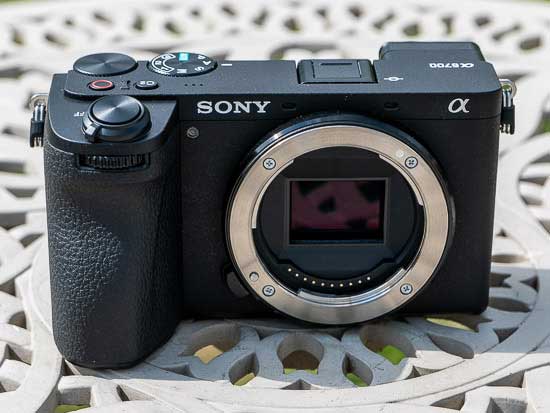
The image sensor is one of the big differences between the A6700 and the EOS R7, and a good reason why you should choose one over the other.
The new Sony A6700 has the same 26 megapixel Exmor R backside-illuminated (BSI) CMOS sensor that was used in the FX30 cinema camera, joined by the latest Bionz XR processor.
The Canon EOS R7 has a higher resolution 32.5 megapixel APS-C CMOS sensor, which is the joint highest resolution currently found in a Canon cropped sensor mirrorless camera.
Note that the A6700 has a backside-illuminated (BSI) sensor whereas the R7 doesn’t. This type of sensor is better at collecting light and should help to improve image quality., so the like-for-like low-light performance may be better from the A6700.
ISO Speed
Both cameras offer exactly the same native ISO range of 100-32,000,
On the A6700, this can be pushed two stops further to ISO 204,800 and dropped down to ISO 50 if required.
On the Canon EOS R7, this can be only expanded up to to ISO 51,200.
Video
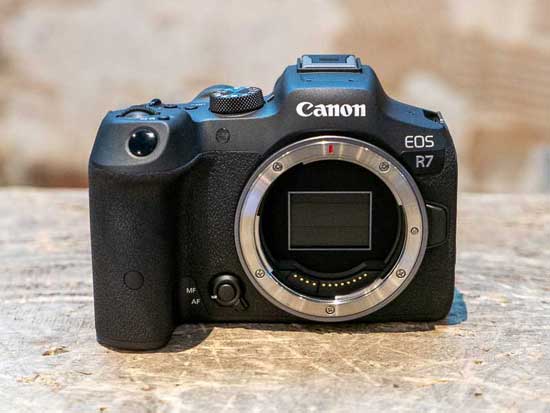
The A6700 can capture oversampled 4K from 6K at up to 60p and also 4K/120p with a 1.62x crop. Video can be captured in 10-bit 4:2:2 or 4:2:0 in either H.265 or H.264 AVC files.
The Slow and Quick motion mode offers frame rates ranging from 1fps to 240fps at 1080p quality.
The Sony A6700 supports the newer Digital Audio Interface (via the Multi Interface Shoe) to enable use of the ECM-B1M digital shotgun microphone.
It offers the clever Auto Framing feature which sues the camera’s AI-based subject recognition technology to automatically crop the frame to keep the subject in a prominent position when shooting movies, even when the camera is mounted on a tripod.
The Canon R7 offers the ability to record uncropped 4K UHD / 60p / 10-bit footage internally with dual-pixel auto-focus and auto-exposure for up to 60 minutes.
There’s also a special 4K/30p Fine mode which oversamples from 7K for the ultimate image quality, and also a dedicated 4K/60p UHD crop mode for extra telephoto reach (55% of the horizontal area).
Full 1080 slow-motion recording at up to 120p with autofocus is also available (but no sound), which is actually something that the flagship EOS R5 doesn’t offer.
The intentionally flat Canon Log 3 colour profile is available to provide extra flexibility for colour grading in post-production.
Autofocus
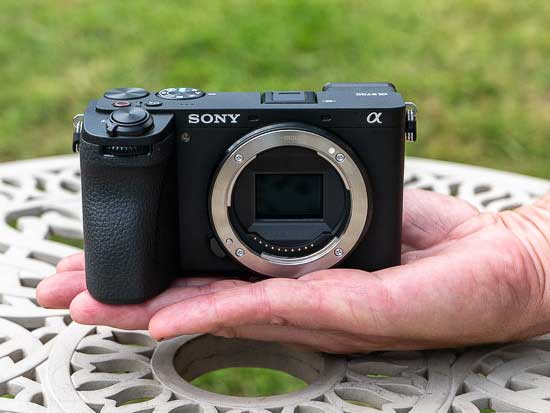
The new A6700 has 759 phase-detection points and 25 contrast points that cover 93% of the frame, with the system working all the way down to -3EV low-light.
The Canon R7 features exactly the next generation Dual Pixel CMOS AF II focusing system as used by the flagship R3 and R5 full-frame cameras.
It has 651 automatic focus points and 5,915 manually selectable AF points with 100% frame coverage in Auto selection mode and 90% vertical and 100% horizontal in manual selection.
The R7 can focus in light levels as low as -5EV (when used with an F1.2 lens) or with maximum apertures as small as f/22, which enables autofocus even when using ultra telephoto lenses with teleconverters.
Both of these cameras offer advanced subject recognition, with the A6700 recognising more subjects than the R7.
Sony has added an AI deep learning processing unit to the A6700 which enables it to recognise far more subjects than previous A6000-series models, and also greatly improves the detection of humans and animals/birds.
For the first time on an Sony APS-C sensor camera. the A6700 can recognise a human via its pose as well as its eye and face. So if the person’s head is turned away from the camera, the A6700 will still accurately detect the subject as human based on its AI deep learning.
Animal and bird detection has been expanded from just being able to recognise the eye on the A6600 to the eye, head and body on the A6700.
As well as humans and animals, the A6700 also has the ability to recognise airplanes, cars, trains and insects.
The EOS R7 offers exactly the same deep-learning artificial intelligence based automatic face, eye and animal (cats, dogs and birds) AF tracking modes as the R3, R5 and R6 models.
The EOS R7 also has the ability to track vehicles, including cars and motorbikes. What’s more, if the driver is wearing a helmet, the AF system will lock on to that, ensuring that the most important subject is in focus.
Burst Shooting
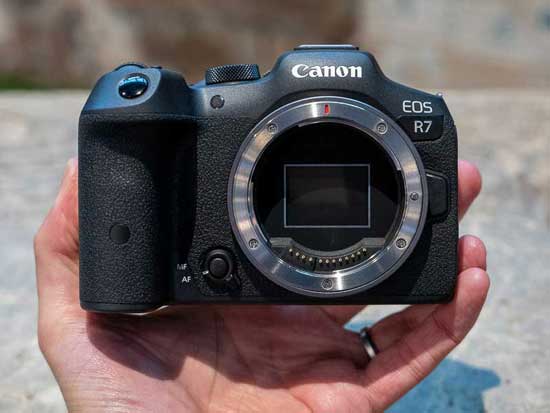
The Sony A6700 offers 11fps burst shooting with Full AF/AE tracking, whilst the R7 can shoot at a blistering 30fps with no crop when taking advantage of the silent electronic shutter and 15fps when using the mechanical shutter.
There is one significant difference between them though that has more of an impact on burst shooting performance – the buffer size.
The A6700 has a much larger buffer than the EOS R7, being able to shoot at 11fps for over 1000 Fine JPEGs, 59 RAW images or 44 RAW and JPEGs in one high-speed burst.
In comparison the EOS R7 can only manage 224 JPEG or 51 RAW images when using the mechanical shutter or 126 JPEG or 42 RAW images when using the electronic shutter.
Body
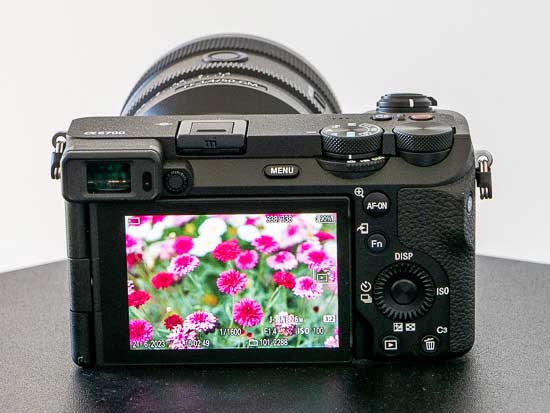
These two cameras take a markedly different approach in terms of their design and control layout, with the A6700 following the long-established rangefinder-esque format of the A6000-series cameras, while the EOS R7’s design is more “DSLR-like” with the viewfinder in the centre.
The R7 is slightly heavier, weighing in at 530g body-only or 612g with both a battery and memory card fitted.
Viewfinder
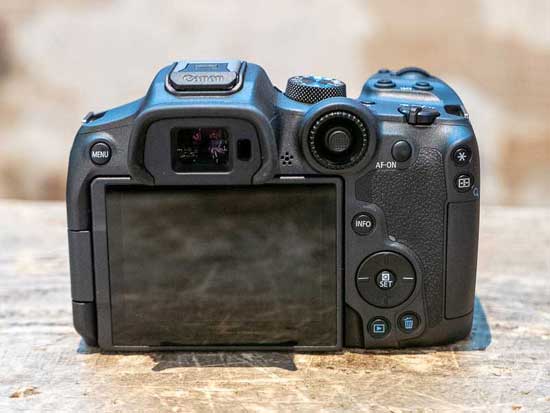
The A6700 has a very similar 2.36million-dot XGA OLED electronic viewfinder to the one used by the EOS R7.
It features 0.70x magnification, 23mm eyepoint, 100% scene coverage and either a 60fps or 120fps frame rate setting, the latter helping to help track moving subjects more smoothly with virtually no lag.
The Canon R7 has an electronic viewfinder with 2.36M-dot resolution, magnification of 10.72x and 120fps refresh rate.
LCD Screen
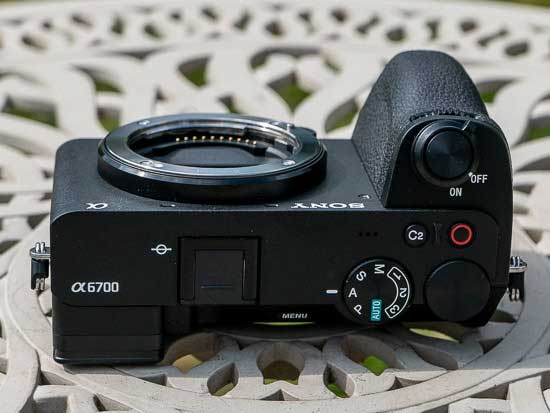
The Alpha 6700 has a lower-resolution 3-inch, 3:2 ratio LCD screen than the EOS R7 – 1.03-million versus 1.62-million dots – we’d have expected to see a much higher resolution screen on a new camera released in 2023.
The LCD monitor on both cameras has a vari-angle design that is arguably more versatile and better suited to video use.
You can flip out the screen to the side, rotate it forwards for easier operation when pointing the camera at yourself, and fold it flat against the back of the camera to stop it from getting scratched. It is a more versatile screen for vlogging, movie shooting and photography in general.
IBIS
Both cameras have 5-axis optical in-body image stabilisation that corrects for pitch and yaw shake.
The A6700 is rated for up to 5 stops of compensation. Sony claim that the A6700 has an updated algorithm that provides more precise control and detection down to the single pixel level, but we’re not sure at this point what material effect that has on the resulting images.
The R7 goes three steps better by offering up to 8-stops of image stabilisation available via a combination of the camera’s in-body Image Stabiliser which works in tandem with the attached lens’ own stabilisation system.
Memory Cards
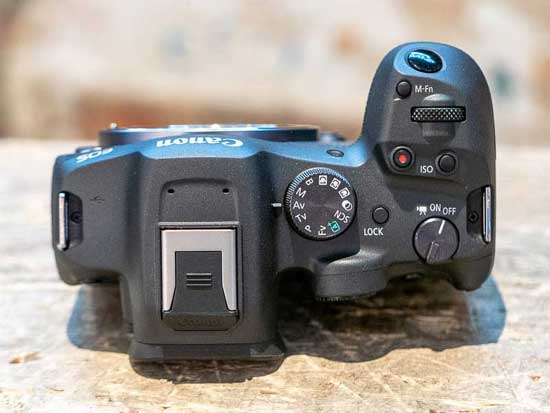
The Sony A6700 only has a single SD UHS-II memory card slot, whereas the EOS R7 has dual memory card slots, both of which support UHS-II SD cards.
Battery Life
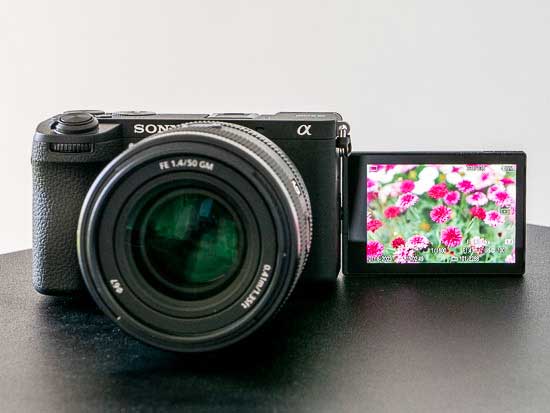
The Sony A6700 offers a CIPA-rated battery life of around 700 shots when using the LCD screen and 750 when using the viewfinder.
The EOS R7 can record 500 shots when using the EVF and 770 when using the LCD screen before the battery runs out.
Both cameras can also be powered and charged via a USB-C connection, which is useful if you’re out and about and have a compatible power-bank to plug the camera into.
Price
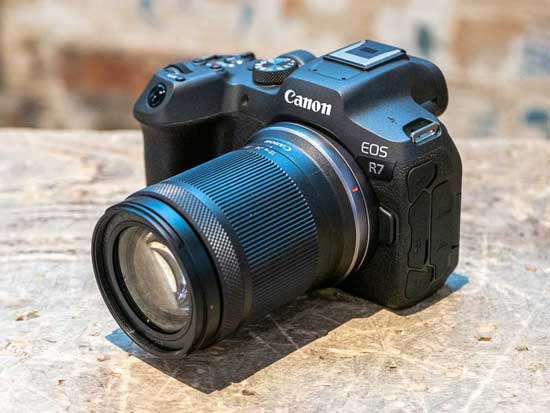
The Sony A6700 has a price-tag of £1450 / €1700 body only, £1550 / €1800 with the Sony E PZ 16-50mm F3.5-5.6 OSS kit lens or £1800 / €2100 with the E 18-135mm F3.5-5.6 OSS zoom lens.
In comparison, the Canon EOS R7 is priced at £1349 / $1499 body-only, making it slightly cheaper than the A6700.
Conclusion
The Canon EOS R7 offers more megapixels, much faster burst shooting, three-stops better IBIS system, a higher-resolution LCD screen, dual memory cards and a lower price, while the Sony A6700 provides slightly more capable video recording, a bigger buffer for burst shooting, larger ISO range, a backside-illuminated (BSI) sensor, more sophisticated subject detection, and longer battery life.
So what do you think? Would you choose the Sony A6700 or the Canon EOS R7? Leave a comment below!
Your Comments
Credit : Source Post



